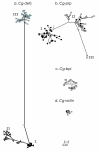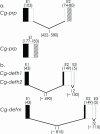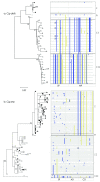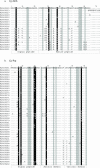Molecular diversity of antimicrobial effectors in the oyster Crassostrea gigas
- PMID: 20100329
- PMCID: PMC2823732
- DOI: 10.1186/1471-2148-10-23
Molecular diversity of antimicrobial effectors in the oyster Crassostrea gigas
Abstract
Background: To gain insight into the molecular diversity of antimicrobial peptides and proteins in the oyster Crassostrea gigas, we characterized and compared the sequence polymorphism of the antimicrobial peptides (AMPs), Cg-Defensins (Cg-Defs) and Cg-Proline Rich peptide (Cg-Prp), and of the bactericidal permeability increasing protein, Cg-BPI. For that, we analyzed genomic and transcript sequences obtained by specific PCR amplification and in silico searches.
Results: High diversification among the three antimicrobial effectors was evidenced by this polymorphism survey. On the basis of sequence phylogenies, each AMP aggregates into clearly defined groups of variants and is the product of a multigenic family displaying a variety of gene structures. In contrast, Cg-bpi forms a single group and is encoded by a single gene copy. Moreover, we identified for both AMPs several genetic mechanisms of diversification such as recombination, parallel mutations leading to phylogenetic homoplasy and indel events. In addition, the non synonymous to synonymous substitutions ratio by codon (dN/dS) revealed several negatively and positively selected sites for both AMPs, suggesting that directional selection pressures have shaped their sequence variations.
Conclusions: This study shows for the first time in a mollusc that antimicrobial peptides and proteins have been subject to distinct patterns of diversification and we evidence the existence of different evolutionary routes leading to such sequence variability.
Figures




References
-
- Gueguen Y, Herpin A, Aumelas A, Garnier J, Fievet J, Escoubas JM, Bulet P, Gonzalez M, Lelong C, Favrel P. Characterization of a defensin from the oyster Crassostrea gigas. Recombinant production, folding, solution structure, antimicrobial activities, and gene expression. J Biol Chem. 2006;281(1):313–323. doi: 10.1074/jbc.M510850200. - DOI - PubMed
Publication types
MeSH terms
Substances
LinkOut - more resources
Full Text Sources
Research Materials

